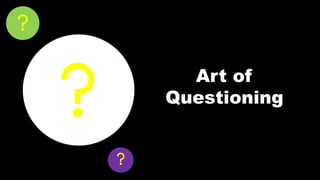
Art of Questioning: Recognizing the Importance of Creative Inquiry
- 2. Session Objectives At the end of the session, participants will be able to recognize the importance of art of questioning. Terminal:
- 3. Session Objectives 1. Describe questioning as an art. 2. Determine ways of writing good questions. 3. Write appropriate questions. Enabling:
- 5. ART - skill acquired by experience, study, or observation - a branch of learning: - an occupation requiring knowledge or skill - the conscious use of skill and creative imagination especially in the production of aesthetic objects
- 6. TEACHING IS AN ART.
- 8. It is the ACTIVITY or PROCESS of asking QUESTIONS.
- 10. All teaching and learning lies in the art of questioning. Questioning which is the basis of teaching task encourages recalling , deepens the learning process and comprehension , promotes the imagination and problem-solving , satisfies the sense of curiosity , and increases the creativity. Reference: Zolfaghari, A. R., Fathi, D., & Hashemi, M. (2011, December 27). Role of creative questioning in the process of learning and teaching. Procedia - Social and Behavioral Sciences. Retrieved May 18, 2022, from https://www.sciencedirect.com/science/article/pii/S1877042811022294#:~:text=All%20teaching%20and%20learning%20lies,curiosity% 20%2C%20and%20increases%20the%20creativity%20.
- 11. Researches show that primary school teachers and students usually ask one question every two minutes .This amount is much lower in guidance school and high school. On the other hand only about 8% of the questions are posed for encouraging the students’ thinking and reflection. Creativity which is the most sublime and exquisite gift of God to human helps nations and cultures progress rapidly. Source: Zolfaghari, A. R., Fathi, D., & Hashemi, M. (2011, December 27). Role of creative questioning in the process of learning and teaching. Procedia - Social and Behavioral Sciences. Retrieved May 18, 2022, from https://www.sciencedirect.com/science/article/pii/S1877042811022294#:~:text=All%20teaching%20and%20learning%20lies,curiosity% 20%2C%20and%20increases%20the%20creativity%20.
- 13. Low inquiry questions These questions focus on previously learned knowledge in order to answer questions posed by the teacher which require the students to perform ONE of the following tasks: 1. Elicit the meaning of a term. 2. Represent something by a word or a phrase. 3. Supply an example of something.
- 14. Low inquiry questions 4. Make statements of issues, steps in a procedure, rules, conclusions, ideas and beliefs that have previously been made. 5. Supply a summary or a review that was previously said or provided. 6. Provide a specific, predictable answer to a question.
- 15. High inquiry questions These questions focus on previously learned knowledge in order to answer questions posed by the teacher which require the students to perform ONE of the following tasks: 1. Rate some entity as to its value, dependability, importance, or sufficiency with a defense of the rating. 2. Find similarities or differences in the qualities of two or more entities utilizing criteria defined by the student.
- 16. High inquiry questions 3. Make a prediction that is the result of some stated condition, state, operation, object, or substance. 4. Make inferences to account for the occurrence of something (how or why it occurred).
- 17. Type of Question Learners’ responses Type of response Examples Low inquiry (convergent) • Recall, memorize •Describe in own words • Summarize • Classify on basis of known criteria • Give an example of something Closed How many... Define... In your own words...state similarities and differences... What is the evidence...? What is an example...?
- 18. Type of Question Learners’ responses Type of response Examples High inquiry (divergent) • Create unique or original design, report, inference, prediction • Judge scientific credibility • Give an opinion or state an attitude • Make value judgements about issues Open Design an experiment... What do you predict...? What do you think about...? Design a plan that would solve...? What evidence can you cite to support...? Source: https://www.jackhassard.org/mos/8.3c.html
- 20. Socratic Method Developed by the Greek philosopher, Socrates, the Socratic Method is a dialogue between teacher and students, instigated by the continual probing questions of the teacher, in a concerted effort to explore the underlying beliefs that shape the students views and opinions. Source: https://tilt.colostate.edu/TipsAndGuides/Tip/53#:~:text=What%20is%20the%20Socratic%20Method,the%20st udents%20views%20and%20opinions.
- 21. I cannot teach anybody anything; I can only make them think. - Socrates